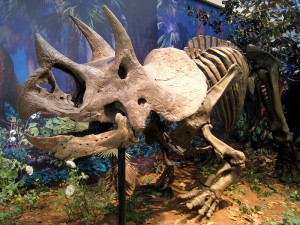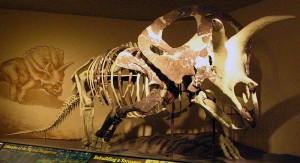Earlier this year a paper was published (Scannella and Horner 2010) on one of the most well-known dinosaurs of the Late Cretaceous, Triceratops, updating our understanding of not only this dinosaur species, but also maybe influencing our view of many other dinosaur species as well.
Triceratops was first described in 1889 by O. C. Marsh, and has become one of the best represented dinosaur species in terms of numbers of fossils recovered. Their remains are very common in the Hell Creek Formation of Montana and the Dakotas. And, Triceratops has been known by practically every kid for the last 100 years, being well represented in dinosaur movies and dinosaur toys the world over.
Triceratops is best known for its three horns and neck frill of bone. Torosaurus, another dinosaur that is obviously related to Triceratops because of its similar appearance, was also first named by Marsh in 1891. It is found in the same geologic units in the same region, but is much less commonly found. Torosaurus was much larger than Triceratops, and had large openings in the neck frill, and its horns pointed more anteriorly.
So, for over 100 years paleontologists thought there were at least two species of horned dinosaurs in these beds. But scientific understanding makes progress. In the early “bone rush” days of the nineteenth century the game was naming new species. Today, there is a trend of relooking at those species to see if they are in fact different.
This is where the new study comes in. The authors examined Triceratops and Torosaurus and questioned whether they might not be the same species, but at different life stages. It has become apparent that individuals of a species can change a great deal over their lifetimes. A newborn human does not look much like an adult in body proportions, for example. If past species also changed significantly over their lifetimes, the different stages could easily be mistaken as completely different species. And that seems to be the case here.
By looking closely at the trends of skull shape and indicators of maturity, Scannella and Horner believe that in fact Torosaurus individuals are older and more mature individuals of Triceratops. This means that later in their development individual Triceratops specimens changed significantly as they reached maturity, developing the large openings in the neck frill and increasing in overall size.
The implications for other dinosaur species are clear. If individuals can change dramatically during their lifetimes as they mature, perhaps there are many named dinosaurs that are not truly different and unique species, and we need to match youngsters with adults. No doubt this will keep paleontologists busy for the next 100 years.
And in case you are worried, the name Triceratops will remain, since it was the first name given to the species that we now realize includes those individuals that one were called “Torosaurus.” So, despite some headlines Triceratops did (and still does) exist!
Scannella, J. B., and J. R. Horner. 2010. Torosaurus Marsh, 1891, is Triceratops Marsh, 1889 (Ceratopsidae: Chasmosaurinae): synonymy through ontogeny. Journal of Vertebrate Paleontology 30(4):1157 – 1168.

